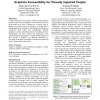CHI
2007
ACM
15 years 1 months ago
2007
ACM
We trace how cultural probes have been adopted and adapted by the HCI community. The flexibility of probes has been central to their uptake, resulting in a proliferation of diverg...
CHI
2007
ACM
15 years 1 months ago
2007
ACM
We present the case study of a complex, mixed-initiative scheduling system to illustrate Work-Centered Design (WCD), a new approach for the design of information systems. WCD is b...
CHI
2007
ACM
15 years 1 months ago
2007
ACM
A number of recent studies have demonstrated that groups benefit considerably from access to shared visual information. This is due, in part, to the communicative efficiencies pro...
CHI
2007
ACM
15 years 1 months ago
2007
ACM
We present an evaluation of mudibo, a prototype system for determining the position of dialog boxes in a multiplemonitor system. The analysis shows that, when compared to a standa...
CHI
2007
ACM
15 years 1 months ago
2007
ACM
To date, efforts have been made to enable visually impaired people to gain access to graphics on the Internet. However, these studies only offer a solution for a specific type of ...
CHI
2007
ACM
15 years 1 months ago
2007
ACM
For years the HCI community has struggled to integrate design in research and practice. While design has gained a strong foothold in practice, it has had much less impact on the H...
CHI
2007
ACM
15 years 1 months ago
2007
ACM
Transfer scenarios is a method developed to support the design of innovative interactive technology. Such a method should help the designer to come up with inventive ideas, and at...
CHI
2007
ACM
15 years 1 months ago
2007
ACM
Wikipedia, a wiki-based encyclopedia, has become one of the most successful experiments in collaborative knowledge building on the Internet. As Wikipedia continues to grow, the po...
CHI
2007
ACM
15 years 1 months ago
2007
ACM
Technology arguably has the potential to play a key role in improving the lives of people in developing regions. However, these communities are not well understood and designers m...
CHI
2007
ACM
15 years 1 months ago
2007
ACM
Poor literacy remains a decisive barrier to the economic empowerment of many people in the developing world. Of particular importance is literacy in a widely spoken "world la...





